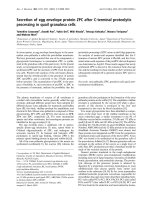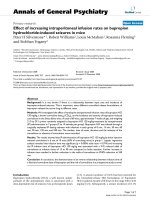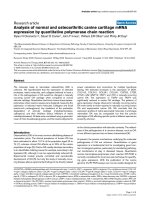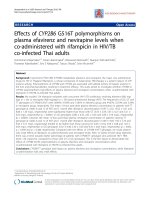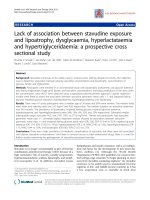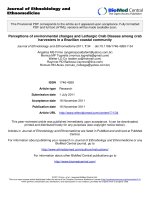Báo cáo y học: "Resolution of cast nephropathy following free light chain removal by haemodialysis in a patient with multiple myeloma: a case report" ppsx
Bạn đang xem bản rút gọn của tài liệu. Xem và tải ngay bản đầy đủ của tài liệu tại đây (479.77 KB, 5 trang )
BioMed Central
Page 1 of 5
(page number not for citation purposes)
Journal of Medical Case Reports
Open Access
Case report
Resolution of cast nephropathy following free light chain removal by
haemodialysis in a patient with multiple myeloma: a case report
Kolitha Basnayake*
1
, Colin Hutchison
1
, Dia Kamel
1
, Michael Sheaff
2
,
Neil Ashman
2
, Mark Cook
1
, Heather Oakervee
2
, Arthur Bradwell
3
and
Paul Cockwell
1
Address:
1
Queen Elizabeth Medical Centre, University Hospital Birmingham, Edgbaston, Birmingham, B15 2TH, UK,
2
Barts and the London NHS
Trust, Whitechapel, London, E1 1BB, UK and
3
Division of Immunity and Infection, University of Birmingham, Edgbaston, Birmingham, B15 2TT,
UK
Email: Kolitha Basnayake* - ; Colin Hutchison - ; Dia Kamel - ;
Michael Sheaff - ; Neil Ashman - ;
Mark Cook - ; Heather Oakervee - ;
Arthur Bradwell - ; Paul Cockwell -
* Corresponding author
Abstract
Introduction: Acute renal failure in multiple myeloma is most frequently caused by cast
nephropathy, when excess monoclonal free light chains co-precipitate with Tamm-Horsfall protein
in the distal nephron, causing tubular obstruction. The natural history of cast nephropathy after
diagnosis is unknown. This report provides supporting histological evidence that, as serum free light
chain concentrations fall, intratubular casts may resolve within weeks.
Case presentation: We report the case of a 61-year-old Caucasian woman who presented with
multiple myeloma and dialysis-dependent acute renal failure, with serum kappa free light chain
concentrations of 15,700 mg/litre (normal range 3.3 to 19.4 mg/litre). Renal biopsy demonstrated
cast nephropathy with waxy casts in distal tubules and collecting ducts. There was an interstitial
inflammatory cell infiltrate with diffuse fibrosis and tubular atrophy. Following rehydration,
chemotherapy and free light chain removal using high cut-off haemodialysis, free light chain
concentrations fell to less than 5% of the starting level (500 mg/litre). A repeat renal biopsy 6 weeks
after the first showed resolution of cast nephropathy.
Conclusion: These observations indicate that cast nephropathy can quickly resolve on rapid
reduction of monoclonal serum free light chains. This has important implications for the
development of treatment strategies aimed at improving renal recovery rates for patients in this
setting.
Introduction
Renal failure in multiple myeloma (MM) is associated
with high morbidity and mortality. Approximately 10%
of newly diagnosed patients require dialysis. Of these,
80% will not recover renal function [1,2]. The predomi-
nant cause of dialysis-dependent renal failure in this set-
Published: 9 December 2008
Journal of Medical Case Reports 2008, 2:380 doi:10.1186/1752-1947-2-380
Received: 15 May 2008
Accepted: 9 December 2008
This article is available from: />© 2008 Basnayake et al; licensee BioMed Central Ltd.
This is an Open Access article distributed under the terms of the Creative Commons Attribution License ( />),
which permits unrestricted use, distribution, and reproduction in any medium, provided the original work is properly cited.
Journal of Medical Case Reports 2008, 2:380 />Page 2 of 5
(page number not for citation purposes)
ting is cast nephropathy. Monoclonal free light chains
(FLCs) are freely filtered by the glomerulus, following
which they are reabsorbed and metabolised by the proxi-
mal tubule epithelium. When the burden of filtered FLC
exceeds this resorptive capacity, FLC will then pass
through into the distal nephron. Here co-precipitation
with Tamm-Horsfall protein (THP) occurs resulting in
intratubular obstruction [3-5].
The natural history of the pathology of cast nephropathy
is unknown. There has been one previous report of a fol-
low-up renal biopsy after the initial diagnostic biopsy
showing myeloma kidney [6]. This patient was treated
with chemotherapy and initially received haemodialysis,
converting to continuous ambulatory peritoneal dialysis.
The patient became dialysis-independent after 3 months
with an associated reduction in serum paraprotein con-
centration and urinary light chain excretion. A repeat
renal biopsy at 8 months showed no cast nephropathy.
Only one recent study has accurately assessed the kinetics
of FLCs in patients with severe renal failure [7]. This report
indicated that serum FLC concentrations remained ele-
vated for many weeks despite effective induction chemo-
therapy. It also showed that high cut-off haemodialysis
led to rapid reduction in serum FLCs and with effective
chemotherapy, this reduction is maintained.
We report a case of a patient with cast nephropathy which
resolved within 6 weeks after treatment with chemother-
apy and high cut-off haemodialysis.
Case presentation
A 61-year-old Caucasian woman presented to her general
practitioner complaining of feeling tired and weak. She
had previously been fit and well, and did not take any
medications. Initial investigations revealed that she was in
acute renal failure with a serum creatinine of 872 μmol/
litre and serum urea of 31.5 mmol/litre. Serum calcium
and urate levels were normal. Haemoglobin concentra-
tion was 7.8 g/dl (78 g/litre). Urine output was approxi-
mately 2 liters/day.
Serum immunofixation electrophoresis identified mono-
clonal free kappa light chains. FLC concentrations were
quantified using a serum immunoassay [8] (FREELITE,
The Binding Site, Birmingham, UK): serum kappa 15,700
mg/litre (normal range 3.3 to 19.4 mg/litre) [9], urine
kappa 2450 mg/litre, serum lambda 22.4 mg/litre (5.7 to
26.3 mg/litre) [9], kappa/lambda ratio 701 (normal
range: 0.26 to 1.65) [9]. Immunoglobulin concentrations
were: IgG 6.81 g/litre (6 to 16 g/litre), IgA 0.79 g/litre (0.8
to 4.0 g/litre) and IgM 0.38 g/litre (0.5 to 2.0 g/litre). Lytic
lesions were seen on skeletal survey. Bone marrow exam-
ination showed 90% plasma cell infiltration. Renal ultra-
sound was unremarkable. Renal biopsy demonstrated
waxy casts consistently affecting approximately 30% of
distal tubules and collecting ducts, with associated peritu-
bular inflammatory cell infiltrate (Figure 1A). There was
moderate diffuse interstitial fibrosis and tubular atrophy.
A diagnosis of multiple myeloma and acute renal failure
due to cast nephropathy was made.
For the first 4 weeks, the patient was managed with intra-
venous hydration. During this time, a 40% reduction in
serum FLC concentration to 8590 mg/litre was seen, but
she remained in severe renal failure with an eGFR of <10
ml/min/1.73 m
2
. Chemotherapy was then initiated with
pulsed high-dose dexamethasone. Each pulse consisted of
40 mg once daily for 4 days.
Thalidomide 100 mg daily was added 7 days later. FLC
concentrations were reduced further to 1990 mg/litre 5
days after initiation of the first pulse. FLC removal haemo-
dialysis was commenced at this point, using a high cut-off
dialyser with increased permeability to substances up to a
molecular weight of 60 kDa [7] (HCO 1100; Gambro Dia-
lysatoren GmbH, Hechingen, Germany).
Two dialysers were used in series as previously described
[7]. The patient was dialysed for 3 hours on day 1 and 6 to
8 hours on days 2 to 6. Three further dialysis sessions of 8
hours were performed from days 8 to 14. Following this,
the patient continued on a thrice weekly 4 to 6 hour dial-
ysis schedule. Figure 2 presents serum-free kappa concen-
trations pre- and post-dialysis as well as a summary of the
chemotherapy regimen. The median decrease in serum
FLC concentration was 74% (range: 35 to 88%) per dialy-
Renal biopsiesFigure 1
Renal biopsies. (A) High power haematoxylin and eosin
stained section of the first biopsy showing hard, fractured
casts with associated giant cell reaction. There is a peritubu-
lar inflammatory cell infiltrate, with significant interstitial
fibrosis and tubular atrophy. (B) High power haematoxylin
and eosin stained section of the second biopsy demonstrating
resolution of myeloma casts. There is partial resolution of
the interstitial inflammatory infiltrate. The degree of intersti-
tial fibrosis and tubular atrophy remained unchanged.
Journal of Medical Case Reports 2008, 2:380 />Page 3 of 5
(page number not for citation purposes)
sis session. Albumin, magnesium and calcium losses were
replaced when indicated.
After 16 dialysis treatments, 33 days after the start of
chemotherapy, serum kappa FLC concentrations had
fallen to less than 500 mg/litre and were subsequently
maintained below this level. Despite this, the patient
remained dialysis-dependent. Another renal biopsy was
performed. This showed no evidence of myeloma casts
and partial resolution of the inflammatory infiltrate,
while the degree of diffuse moderate interstitial fibrosis
remained unchanged (Figure 1B).
Both the first and second biopsies were examined by light
microscopy in detail along their entire lengths for the
presence of casts. Both contained adequate cortical tissue.
Tubules in three randomly selected high-power fields
from each biopsy were counted. The average number of
tubules were 110 for the first biopsy and 121 for the sec-
ond biopsy per high power field.
The patient had 22 haemodialysis treatments using the
high cut-off dialyser. As FLC levels remained below 500
mg/litre, she was switched to a standard high flux sched-
ule. A further 5 days later, 8 weeks from the commence-
ment of chemotherapy, in accordance with the patient's
own wishes, haemodialysis was discontinued. Creatinine
level at this point was 650 μmol/litre.
At 1 year after discontinuation of dialysis, the patient
remains symptomatically well and the myeloma is in
remission. Her current eGFR is 8 ml/min/1.73 m
2
based
on a serum creatinine of 540 μmol/litre, with a main-
tained urine output. She is clinically well with no symp-
toms of uraemia and has elected to remain independent
of dialysis until she develops clinical symptoms indicative
of uraemia.
Discussion
There are several explanations for resolution of the cast
nephropathy. First, resorption via receptor-mediated
processes by tubular epithelium and/or mononuclear
cells. This is unlikely as the casts represent solid precipi-
tates and distal tubular cells and monocytes have no
known receptors for FLC-THP aggregates. Second, tubular
epithelial and mononuclear cells might phagocytose cast
fragments. This would imply that casts become increas-
ingly friable when FLC concentrations fall below the
threshold for further cast formation. But this is not
observed histologically. Third, and most likely, tubular
cast formation is a dynamic process in patients where
there is urine flow. Driven by a high serum light chain
load, casts continually precipitate. However, in the pres-
ence of sustained glomerular ultrafiltrate, they pass
through and out of the intranephronal compartment.
Indeed, light chain casts are detected in the urine of
patients with cast nephropathy [10]. Therefore, when
serum FLC concentrations are reduced, new cast forma-
tion ceases and existing casts are flushed out of the
tubules. The two biopsies we report may reflect this
dynamic process.
At the first biopsy, the histological findings of cast neph-
ropathy, inflammatory cell infiltrate and interstitial fibro-
sis were concurrent with serum concentrations of serum
kappa FLC well above those required to produce cast
nephropathy [5]. Serum FLC concentrations dropped by
40% after initial intravenous fluid therapy, indicating that
volume contraction secondary to dehydration contrib-
uted to the very high presenting FLC concentrations.
Rehydration had both a dilutional effect as well as aiding
renal clearance, consistent with a maintained urine out-
put. Five days after commencement of the first cycle of
dexamethasone, FLC levels had fallen significantly, indi-
cating a strong tumour killing effect. Following com-
mencement of FLC removal by dialysis, the
concentrations continued to fall. Five weeks after com-
mencement of dexamethasone, serum FLC concentrations
were below 500 mg/litre, the likely minimal threshold for
the formation of casts [5].
Whilst cast nephropathy contributes to acute renal failure
in myeloma associated with high concentrations of serum
FLC, other mechanisms are important. Recent studies
have shown that monoclonal FLC are capable of inducing
cytoskeletal damage, epithelial-to-mesenchymal transi-
Serum free kappa light chain concentrationsFigure 2
Serum free kappa light chain concentrations. Changes
in concentration with dialysis and chemotherapy with time
are shown. Pre-dialysis and post-dialysis values are connected
by lines. The concentration at the start of the first pulse of
dexamethasone is also shown. The arrowheads represent
daily doses of dexamethasone. Daily thalidomide is indicated
by the solid line at the top of the chart.
Journal of Medical Case Reports 2008, 2:380 />Page 4 of 5
(page number not for citation purposes)
tion and apoptosis in proximal tubular epithelial cells in
culture, as well as effecting the release of inflammatory
cytokines and production of hydrogen peroxide [11-13].
The degree of toxicity and tendency to direct cellular tox-
icity or cast formation has been shown to be dependent
on the clonal origin of the light chain species [11,14]. This
direct toxicity may promote the diffuse inflammation and
fibrosis that is commonly seen in patients with myeloma
kidney [12]. The effects of FLC therefore may be to con-
tribute to direct tubular damage sufficient to produce olig-
uria through tubulo-glomerular feedback loops. There
may then be proximal extension of distal casts and irre-
versible acute renal failure. The severity of acute renal fail-
ure and oliguria therefore may be a product of tubular
toxicity, tubular obstruction, dehydration and com-
pounding factors such as the use of diuretics, non-steroi-
dal anti-inflammatory agents and renin-angiotensin
system blockade. This may explain why oliguria was not a
feature in our patient.
The repeat renal biopsy showed complete resolution of
the casts and the interstitial fibrosis remained unchanged
from the first biopsy indicating that there was no progres-
sion in situ from the time of the initial biopsy. This would
be consistent with the observed rapid reduction in FLC
concentrations.
In contrast to the case described previously in the litera-
ture, our patient did not recover renal function despite
rapid, sustained reductions in FLC concentrations and the
subsequent disappearance of intratubular casts within 6
weeks of treatment. We speculate there are two reasons for
this. First, significant interstitial fibrosis was present in the
first biopsy, which developed as a result of exposure to
high levels of FLC before presentation. Second, continued
exposure to FLC even at concentrations too low to cause
cast formation contributed to ongoing inflammation.
This would be consistent with incomplete resolution of
the inflammatory infiltrate.
The patient was withdrawn from dialysis through per-
sonal choice as she was symptomatically well with no
uraemic symptoms, despite having an eGFR of 8 ml/min/
1.73 m
2
. This is not entirely inconsistent with current
practice in the UK, where the average eGFR at initiation of
dialysis for individuals of similar age is around 8.4 ml/
min/1.73 m
2
[15].
Although chemotherapy combined with high molecular
weight cut-off haemodialysis effectively reduces the FLC
burden on the kidneys, whether renal recovery is achieved
or not may depend on the toxicity of the patient's particu-
lar light chain clone as well as prompt diagnosis and insti-
tution of treatment to reduce FLC concentrations.
Conclusion
In summary, we believe that this report provides histolog-
ical evidence that as serum FLC concentrations fall,
intratubular casts can resolve within weeks. Early diagno-
sis and treatment may facilitate reversal of acute renal fail-
ure. This observation has important implications for the
development of combined haematological and renal
treatment strategies aimed at improving renal recovery
rates in this setting.
Abbreviations
eGFR: estimated glomerular filtration rate; FLC: free light
chain; H&E: haematoxylin and eosin; MM: multiple mye-
loma; THP: Tamm-Horsfall protein
Consent
Written informed consent was obtained from the patient
for publication of this case report and any accompanying
images. A copy of the written consent is available for
review by the Editor-in-Chief of this journal.
Competing interests
Arthur Bradwell is a major stock shareholder in The Bind-
ing Site, Birmingham, UK. FREELITE is produced by The
Binding Site, Birmingham, UK. All other authors declare
that they have no competing interests.
Authors' contributions
KB was chiefly responsible for the gathering, analysis and
interpretation of data, creation of the figures for this
report and was responsible for writing the manuscript. DK
and MS performed histological examination of the renal
biopsies and were major contributors to the content of the
manuscript. CH, NA, MC and HO had significant roles in
data gathering, analysis, interpretation and performing
critical revisions to the manuscript. AB and PC had a sig-
nificant role in data gathering, analysis, interpretation and
provided significant revisions to the manuscript. All
authors read and approved the final manuscript.
Acknowledgements
We wish to thank Oliver Foster and Ann-Marie Phythian for their assist-
ance with the gathering of data and processing of samples.
References
1. Knudsen LM, Hjorth M, Hippe E, Knudsen LM, Hjorth M, Hippe E:
Renal failure in multiple myeloma: reversibility and impact
on the prognosis. Nordic Myeloma Study Group. Eur J Haema-
tol 2000, 65:175-181.
2. Torra R, Blade J, Cases A, Lopez-Pedret J, Montserrat E, Rozman C,
Revert L: Patients with multiple myeloma requiring long-
term dialysis: presenting features, response to therapy, and
outcome in a series of 20 cases. Br J Haematol 1995, 91:854-859.
3. Herrera GA, Joseph L, Gu X, Hough A, Barlogie B: Renal patho-
logic spectrum in an autopsy series of patients with plasma
cell dyscrasia. Arch Pathol Lab Med 2004, 128:875-879.
4. Sanders PW, Booker BB, Bishop JB, Cheung HC: Mechanisms of
intranephronal proteinaceous cast formation by low molec-
ular weight proteins. J Clin Invest 1990, 85:570-576.
Publish with BioMed Central and every
scientist can read your work free of charge
"BioMed Central will be the most significant development for
disseminating the results of biomedical researc h in our lifetime."
Sir Paul Nurse, Cancer Research UK
Your research papers will be:
available free of charge to the entire biomedical community
peer reviewed and published immediately upon acceptance
cited in PubMed and archived on PubMed Central
yours — you keep the copyright
Submit your manuscript here:
/>BioMedcentral
Journal of Medical Case Reports 2008, 2:380 />Page 5 of 5
(page number not for citation purposes)
5. Sanders PW, Booker BB: Pathobiology of cast nephropathy
from human Bence Jones proteins. J Clin Invest 1992,
89:630-639.
6. Rose PE, McGonigle R, Michael J, Boughton BJ: Renal failure and
the histopathological features of myeloma kidney reversed
by intensive chemotherapy and peritoneal dialysis. Br Med J
(Clin Res Ed) 1987, 294:411-412.
7. Hutchison CA, Cockwell P, Reid S, Chandler K, Mead GP, Harrison J,
Hattersley J, Evans ND, Chappell MJ, Cook M, et al.: Efficient
removal of immunoglobulin free light chains by hemodialysis
for multiple myeloma: in vitro and in vivo studies. J Am Soc
Nephrol 2007, 18:886-895.
8. Bradwell AR, Carr-Smith HD, Mead GP, Tang LX, Showell PJ, Dray-
son MT, Drew R: Highly sensitive, automated immunoassay
for immunoglobulin free light chains in serum and urine. Clin
Chem 2001, 47:673-680.
9. Katzmann JA, Clark RJ, Abraham RS, Bryant S, Lymp JF, Bradwell AR,
Kyle RA: Serum reference intervals and diagnostic ranges for
free kappa and free lambda immunoglobulin light chains: rel-
ative sensitivity for detection of monoclonal light chains. Clin
Chem 2002, 48:1437-1444.
10. Cheson BD, De Bellis CC, Schumann GB, Schumann JL, Cheson BD,
De Bellis CC, Schumann GB, Schumann JL: The urinary myeloma
cast. Frequency of detection and clinical correlations in 30
patients with multiple myeloma. Am J Clin Pathol 1985,
83:421-425.
11. Pote A, Zwizinski C, Simon EE, Meleg-Smith S, Batuman V: Cytotox-
icity of myeloma light chains in cultured human kidney prox-
imal tubule cells. Am J Kidney Dis 2000, 36:735-744.
12. Li M, Hering-Smith KS, Simon EE, Batuman V: Myeloma light chains
induce epithelial-mesenchymal transition in human renal
proximal tubule epithelial cells. Nephrol Dial Transplant 2008,
23:860-870.
13. Wang PX, Sanders PW: Immunoglobulin light chains generate
hydrogen peroxide. J Am Soc Nephrol 2007, 18:1239-1245.
14. Sanders PW, Herrera GA, Chen A, Booker BB, Galla JH: Differen-
tial nephrotoxicity of low molecular weight proteins includ-
ing Bence Jones proteins in the perfused rat nephron in vivo.
J Clin Invest 1988, 82:
2086-2096.
15. Farrington K, Udayaraj U, Gilg J, Feest T, Feehally J: New adult
patients starting renal replacement therapy in the UK in
2006. In UK Renal Registry Tenth Annual Report Edited by: Ansell D,
Feehally J, Feest T, Tomson C, Williams AJ, Warwick G. Bristol, UK:
UK Renal Registry; 2007:17-47.


